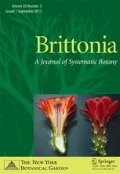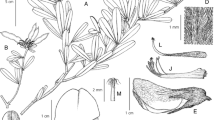Abstract
Tachigali amarumayu, a new species of caesalpinioid legume restricted to terra firme forests in southwestern Amazonia, is described, illustrated, and compared with the morphologically similar species T. prancei, T. rugosa, and T. setifera.
Resumen
Tachigali amarumayu, una nueva especie de leguminosa caesalpinioidea, restringida a los bosques de tierra firme del sudoeste de la Amazonía, es descrita, ilustrada y comparada a especies morfológicamente similares: T. prancei, T. rugosa y T. setifera.




Similar content being viewed by others
Literature cited
Bachman, S., J. Moat, A.W. Hill, J. de la Torre & B. Scott. 2011. Supporting Red List threat assessments with GeoCAT: Geospatial conservation assessment tool. ZooKeys 150: 117–126.
Chomicki, G., Ward, P. S. & Renner, S. S. 2015. Macroevolutionary assembly of ant/plant symbioses: ants and their ant-housing plants in the Neotropics. Proceedings of the Royal Society B: Biological Sciences 282(1819): 20152200.
Ducke, W. A. 1935. Plantes nouvelles ou peu connues de la region amazonienne. VIII. Arquivos do Instituto de Biologia Vegetal 1(3): 205–212.
Dwyer, J. D. 1954. The tropical American genus Tachigalia Aubl. (Caesalpiniaceae). Annals of the Missouri Botanical Garden 41: 223–261.
Dwyer, J. D. 1957. The tropical American genus Sclerolobium Vogel (Caesalpiniaceae). Lloydia 20: 67–117.
Ellis, B., D. C. Daly, L. J. Hickey, J. D. Mitchell, K. R. Johnson, P. Wilf & S. L. Wing. 2009. Manual of leaf architecture. Cornell University Press, Ithaca, New York.
Erdtman, G. 1960. The acetolysis method, a revised description. Sven Botanical Tidskr 54: 561–564.
Erdtman, G. 1972. Pollen morphology and plant taxonomy, angiosperms: An introduction to palynology I. Hafner Publishing Company. New York.
Hesse, M., H. Halbritter, R. Zetter, M. Weber, R. Buchner, A. Frosch–Radivo & S. Ulrich. 2009. Pollen terminology: An illustrated handbook. Springer, Wien, New York and Vienna.
Huamantupa–Chuquimaco, I., H. C. Lima, D. Cardoso, D. Huamán & M. A. Luza–Victorio. 2016. Sinopsis taxonómica, ecológica y etnobotánica del género Tachigali Aubl. (Leguminosae) en la región del Cusco, Perú. Revista Q'EUÑA 7: 7–30.
Jorgensen, P. M., M. H. Nee & S. G. Beck. 2014. Catálogo de las plantas vasculares de Bolivia. Monographs in Systematic Botany from the Missouri Botanical Garden. Vol. 127. St. Louis, Missouri.
Lewis, G. P. 2005. Tribe Caesalpinieae. Pp. 127–161. In: G. Lewis, B. Schrire, B. Mackinder & M. Lock (eds.). Legumes of the world. Royal Botanic Gardens, Kew.
Lima, H. C. 2015 onwards. Tachigali. In: Lista de espécies da flora do Brasil. Jardim Botânico do Rio de Janeiro. http://floradobrasil.jbrj.gov.br/jabot/floradobrasil/FB23195 (Accessed 15 March 2017).
Moulin, L., A. Munive, B. Dreyfus & C. Bolvin–Masson. 2001. Nodulation of legumes by members of the ß sub–class of Proteobacteria. Nature 411: 948–950.
Payne, W. W. A. 1978. Glossary of plant hair terminology. Brittonia 30: 239–255.
Pennington, R. T., M. Lavin & Oliveira-Filho, A. 2009. Woody plant diversity, evolution, and ecology in the tropics: perspectives from seasonally dry tropical forests. Annual Review of Ecology, Evolution and Systematics 40: 437–457.
Pitman, N. C. A., Terborgh, J. W., Silman, M. R., Núñez, P. V., Neill, D. A., Cerón, C. E., Palacios, W. A. & Aulestia, M. 2001. Dominance and distribution of tree species in upper Amazonian terra firme forests. Ecology 82(8): 2101–2117.
Silva, L. F. G. & H. C. de Lima. 2007. Mudanças nomenclaturais no gênero Tachigali Aubl. (Leguminosae–Caesalpinioideae) no Brasil. Rodriguesia 58: 397–401.
Silva, L. F. G., J. T. L, Cardoso, D. B. O. Cardoso & H. C. Lima. 2016. Tachigali spathulipetala, a new threatened caesalpinioid tree species (Leguminosae) from the Brazilian Atlantic Forest. Systematic Botany 41: 971–976.
ter Steege, H., N. C. A. Pitman, D. Sabatier, C. Baraloto, R. P. Salomão et al. 2013. Hyperdominance in the Amazonian tree flora. Science 342: 1243092.
Theobald, W. L., J. L. Krahulik. & R. C. Rollins. 1979. Trichome description and classification. Pp. 40–53. In: C. Metcalfe & L. Chalk (eds.). Anatomy of the dicotyledons. Oxford University Press, Oxford.
van der Werff, H. 2008. A synopsis of the genus Tachigali (Leguminosae: Caesalpinioideae) in northern South America. Annals of the Missouri Botanical Garden. 95: 618–660.
van der Werff, H. 2013. Two new species of Tachigali (Leguminosae) from Brazil and Peru. Kew Bulletin 68(2): 295–299.
Zarucchi, J. & P. Herendeen. 1993. Tachigali (Fabaceae). Pp. 1254–1255. In: L. Brako & J. Zarucchi (eds.). Catalogue of the flowering plants and gymnosperms of Peru. Monographs in Systematic Botany from the Missouri Botanical Garden. Vol. 45. St. Louis, Missouri.
Acknowledgments
We thank the Zoological Society of Frankfurt for supporting exploration and research at the Pampas Heath, where fertile Tachigali amarumayu specimens were collected; Wilfredo Mendoza, Roger Phoco, Christian Quispe, Lourdes D. Villena, T. Zaida Aquino, and Pamela J. Carvajal for logistic support of work carried out in the Pampas del Heath. To SERNANP through of the Jefatura del Parque Nacional Bahuaja Sonene (David Aranibar, Fredy Quispe and parkguards).The following curators and associated herbarium researchers kindly permitted access to their collections: in Peru, Asunción Cano and Betty Millán (USM), Carlos Reynel (MOL), Fructuosa de la Torre and Nailud Ttito (CUZ), Juan Ruiz (AMAZ), Hugo Dueñas and Zofer Baez (HGE); in Bolivia, Luzmila Arroyo and Alejandro Araujo (USZ); in Brazil, Marcos Silveira, Wendeson Castro, Daniel da Silva Costa and Martin Acosta (LabEv collection of Universidade Federal do Acre), Narcísio Bígio and Francis M. Bonadeu (RON), Pedro Viana (MG), and Helena Joseane (IAN). The first author is grateful to the Concytec (Fondecyt-Cienciactiva) and the Rupert Barneby Award for scholarships that made it possible to study the Tachigali collection at NY; to Dr. Benjamin Torke for sharing his invaluable knowledge during discussions on Tachigali and the Leguminosae; to Dr. Douglas Daly for his help with the revision of this manuscript and during the first author’s stay at NYBG; and Dr. Olga Martha Montiel for her support and facilities provided during his visit at MO. D.C. also acknowledges the CNPq Research Productivity Fellowship (306736/2015-2), Prêmio CAPES de Teses (23038.009148/2013-19), and FAPESB (APP0037/2016) for financially supporting his research on legume systematics.
Author information
Authors and Affiliations
Corresponding author
Rights and permissions
About this article
Cite this article
Huamantupa-Chuquimaco, I., C. De Lima, H., Cardoso, D.B.O.S. et al. Tachigali amarumayu (Leguminosae), a new species from terra firme forests of Southwestern Amazonia. Brittonia 71, 39–48 (2019). https://doi.org/10.1007/s12228-018-9547-z
Published:
Issue Date:
DOI: https://doi.org/10.1007/s12228-018-9547-z




